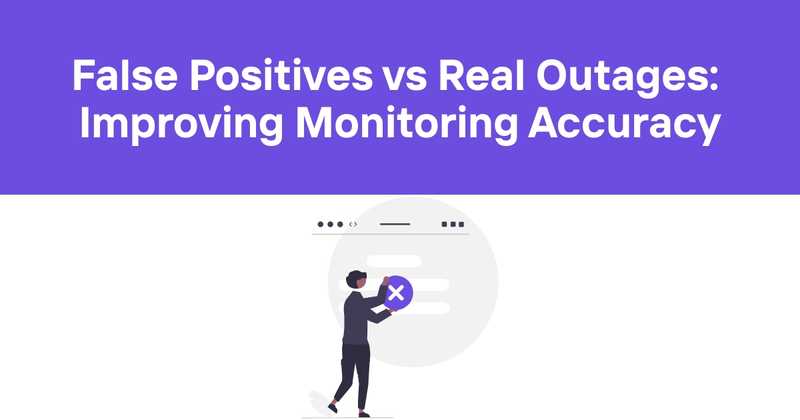False Positives vs Real Outages: Improving Monitoring Accuracy
False positives in uptime monitoring are like that annoying neighbor who keeps reporting your house is on fire when you're just having a barbecue. They waste time, resources, and can lead to alert fatigue—a dangerous condition where your team starts ignoring alerts because they've cried wolf too many times.
I've spent years wrestling with monitoring systems, and if there's one thing that consistently drives ops teams crazy, it's dealing with false positives. But don't worry, we're going to solve this together.
Table of contents
- What are false positives in uptime monitoring?
- Why false positives are a serious problem
- Common causes of false positives
- How to identify false positives
- Technical strategies to reduce false positives
- Configuring retry mechanisms
- Implementing verification from multiple locations
- Setting appropriate thresholds
- Advanced techniques for eliminating false positives
- False positives vs. false negatives
- Creating a false positive response plan
- Choosing the right uptime monitoring solution
What are false positives in uptime monitoring?
False positives in uptime monitoring occur when your monitoring system incorrectly reports that your website or service is down when it's actually functioning properly. It's the digital equivalent of a car alarm going off because a leaf blew by.
In technical terms, a false positive happens when your monitoring tool sends an alert about downtime or performance issues, but when your team investigates, they discover that the service is working fine. These incidents can be triggered by a variety of factors, from network hiccups to monitoring tool configuration issues.
The fundamental problem is that your monitoring system believes it detected a failure when no actual failure existed. This distinction is crucial because addressing false positives requires understanding what triggered the incorrect alert in the first place.
Why false positives are a serious problem
False positives might seem like a minor nuisance, but they can have serious consequences:
- Alert fatigue: When your team receives too many false alarms, they may start ignoring alerts altogether, potentially missing critical issues.
- Wasted resources: Each false alert requires investigation, diverting valuable time and resources away from actual problems.
- Lost trust in monitoring systems: Teams may lose confidence in their monitoring tools if they frequently provide incorrect information.
- Unnecessary stress: Nobody enjoys being woken up at 3 AM for a false alarm.
- Potential business impacts: In extreme cases, false positives might trigger unnecessary disaster recovery procedures or public communications about non-existent issues.
I once worked with a team that received so many false alerts that they created a special Slack channel just for them. Soon, nobody was checking that channel—which eventually led to a real outage being missed. Don't let this happen to you.
Common causes of false positives
Understanding the root causes of false positives is the first step toward eliminating them. Here are the most common culprits:
Network issues between monitor and target
Often, the problem isn't with your service but with the path between your monitoring system and your service. This can include:
- Internet routing problems
- ISP issues
- DNS resolution failures
- Firewall configurations blocking monitoring traffic
- CDN edge node issues
Monitoring agent problems
If you're using self-hosted monitoring agents or private locations, these can become sources of false positives:
- Agent resource constraints (CPU, memory)
- Agent software bugs
- Multiple agents running the same checks (creating duplicate results)
- Agent network connectivity issues
- Agent time synchronization problems
Improper monitor configuration
Sometimes the issue is simply how the monitor is set up:
- Timeout settings that are too strict
- Unrealistic performance thresholds
- Incorrect health check endpoints
- Content validation that's too sensitive
- Monitoring non-critical components
Temporary service glitches
Brief, self-resolving issues can trigger alerts even though they don't represent a significant problem:
- Momentary CPU spikes
- Garbage collection pauses
- Database connection pool exhaustion
- Auto-scaling events
- Load balancer reconfigurations
External dependencies
Your service might depend on external systems that introduce their own instability:
- Third-party API issues
- Payment processor outages
- Authentication service hiccups
- Email delivery problems
- Cloud provider maintenance
How to identify false positives
Before you can fix false positives, you need to identify them. Here are some techniques to determine if an alert is legitimate or a false positive:
-
Cross-verify from multiple sources: Check if the issue is detected from different monitoring locations or tools.
-
Manual verification: Have a team member manually test the affected system.
-
Analyze monitoring data patterns: Look for patterns in when false positives occur (time of day, specific monitoring locations, etc.).
-
Check correlation with other events: See if false positives coincide with deployments, maintenance, or other system changes.
-
Review historical data: Compare with past incidents to identify similarities between known false positives.
One particularly effective approach is to maintain a log of all alerts, classifying them as true or false positives. Over time, patterns will emerge that can guide your remediation efforts.
Technical strategies to reduce false positives
Now that we understand the problem, let's explore specific technical solutions to reduce false positives in your uptime monitoring.
Configuring retry mechanisms
One of the most effective ways to reduce false positives is implementing a retry mechanism. Instead of triggering an alert on the first failed check, the system performs multiple checks before declaring a downtime event.
Here's how to implement an effective retry strategy:
-
Initial detection: When a failure is first detected, mark it as a "potential issue" rather than an immediate alert.
-
Rapid retries: Perform 2-3 quick retries (5-10 seconds apart) to filter out very transient issues.
-
Escalating retries: If the issue persists, increase the interval between retries (30 seconds, 1 minute, 2 minutes) to allow for recovery.
-
Alert threshold: Only trigger an alert after a predetermined number of consecutive failures.
-
Alert resolution: Similarly, require multiple successful checks before declaring the issue resolved.
This approach drastically reduces alerts from momentary glitches while still catching real outages promptly.
function checkUptime(endpoint):
if initialCheck(endpoint) fails:
wait 5 seconds
if retry1(endpoint) fails:
wait 15 seconds
if retry2(endpoint) fails:
wait 30 seconds
if retry3(endpoint) fails:
triggerAlert(endpoint)
Different monitoring tools implement retries differently. Some call it "confirmation checks," others "verification attempts," and some call it "retry on failure." Whatever the name, make sure this feature is enabled and properly configured.
Implementing verification from multiple locations
Network issues are a major source of false positives. A service that's unavailable from one location might be perfectly accessible from another. Using multiple monitoring locations provides a more accurate view of your service's actual availability.
Here's how to effectively implement multi-location monitoring:
-
Geographic distribution: Choose monitoring locations that represent your user base's geographic distribution.
-
Diverse networks: Select locations on different ISPs and network providers.
-
Quorum-based alerting: Only trigger alerts when a majority of locations report an issue.
-
Location-specific thresholds: Adjust sensitivity based on the reliability of each location.
-
Network path analysis: When discrepancies occur between locations, analyze network paths to identify routing issues.
| Location Strategy | Pros | Cons |
|---|---|---|
| Single location | Simple, easy to understand | Highly vulnerable to false positives |
| Multiple locations with ANY logic | Catches regional issues | May increase false negatives |
| Multiple locations with MAJORITY logic | Balanced approach | Requires more configuration |
| Multiple locations with ALL logic | Minimizes false positives | May miss regional outages |
I've found that requiring at least 2 out of 3 locations to confirm an outage offers the best balance between minimizing false positives and catching real issues.
Setting appropriate thresholds
Many false positives stem from unrealistic performance expectations. Setting appropriate thresholds requires understanding your service's normal behavior and what constitutes a true problem.
Consider these factors when establishing thresholds:
- Response time baselines: Use historical data to understand normal response times.
- Performance variations: Account for known patterns like busy periods or maintenance windows.
- Acceptable degradation: Not every slowdown is an emergency.
- Progressive alerting: Use different thresholds for warnings versus critical alerts.
- Dynamic thresholds: Consider tools that adjust thresholds based on historical patterns.
For example, rather than alerting when response time exceeds 500ms, consider using a multiple of the baseline (e.g., 3x the normal response time) or looking for sudden changes rather than absolute values.
Advanced techniques for eliminating false positives
Beyond the basics, there are several advanced approaches that can further reduce false positives:
Content validation tuning
Many monitoring systems can validate page content to ensure the service is not just responding but functioning correctly. However, overly strict validation can lead to false positives:
- Avoid exact string matches: Prefer partial matching or regular expressions.
- Focus on stable elements: Validate content that doesn't change frequently.
- Use negative validations: Sometimes checking for error messages is more reliable than looking for expected content.
- Consider DOM structure: For web applications, validate structure rather than exact text.
Correlation across services
Modern applications often involve multiple interconnected services. Using correlation can help distinguish between isolated false positives and real issues:
- Service dependency mapping: Understand which services depend on each other.
- Intelligent grouping: Group alerts from related services.
- Root cause analysis: When multiple services fail, identify the probable root cause.
- Suppression rules: Automatically suppress downstream alerts when upstream services fail.
Statistical anomaly detection
Rather than fixed thresholds, statistical approaches can adapt to changing conditions:
- Baseline modeling: Build models of normal behavior that account for time of day, day of week, etc.
- Outlier detection: Flag observations that deviate significantly from expected patterns.
- Trend analysis: Look for concerning trends rather than point-in-time violations.
- Machine learning: More sophisticated systems can learn complex patterns and predict issues before they cause outages.
False positives vs. false negatives
It's important to recognize that there's a natural tension between reducing false positives and avoiding false negatives (missing real outages). Every change that reduces false positives potentially increases the risk of missing real issues.
Finding the right balance depends on your specific requirements:
- Critical services: For truly critical services, you might tolerate more false positives to ensure you catch every real issue.
- Non-critical services: For less critical services, you might prioritize reducing false positives even if it means occasionally missing minor issues.
The key is making this tradeoff consciously rather than accidentally. Document your monitoring philosophy and ensure your team understands the approach you've chosen.
Creating a false positive response plan
Even with the best prevention, some false positives will occur. Having a clear plan for handling them is essential:
- Rapid verification process: Define a quick way to verify if an alert is real.
- Escalation criteria: Establish when to wake people up versus when to wait.
- Documentation requirements: Track each false positive for later analysis.
- Continuous improvement loop: Regularly review and address causes of false positives.
- Monitoring adjustments: Have a process for tuning monitoring based on false positive data.
Here's a simple false positive response template:
- Receive alert
- Perform quick verification (check from another location, basic tests)
- If clearly a false positive, document details and adjust monitoring
- If uncertain, escalate for further investigation
- After resolution, add to false positive tracking system
- Monthly review of all false positives to identify patterns
Choosing the right uptime monitoring solution
Your choice of monitoring tool significantly impacts your experience with false positives. Here are key features to look for:
Multi-location monitoring
As we've discussed, monitoring from multiple locations is crucial for reducing network-related false positives. Ensure your tool offers:
- Diverse geographic locations
- Different ISPs and network providers
- Configurable verification logic across locations
Flexible retry configurations
Look for systems that provide:
- Configurable retry counts
- Adjustable intervals between retries
- Different retry strategies for different types of checks
Intelligent alerting
Advanced alerting features can dramatically reduce noise:
- Correlation between related checks
- Anomaly detection capabilities
- Alert grouping and suppression rules
- Customizable notification thresholds
Historical data and analysis
To identify and address patterns of false positives, you need:
- Detailed historical data retention
- Visualization of monitoring trends
- Anomaly highlighting
- Performance baseline tracking
Integration capabilities
Your monitoring solution should integrate with:
- Incident management systems
- Communication tools
- Ticketing systems
- Status page platforms
Odown offers all these critical features, making it particularly effective at minimizing false positives while ensuring you catch real issues. Its multi-region monitoring with configurable verification logic is specifically designed to address the leading causes of false positives.
Real-world examples of reducing false positives
Let me share a few examples from real organizations that successfully tackled false positive problems:
E-commerce platform
An e-commerce company was experiencing frequent false positives from their API monitoring. They discovered that their payment processing API occasionally had brief latency spikes that triggered alerts but didn't affect customers.
Solution:
- Increased the timeout threshold from 2 seconds to 5 seconds
- Implemented a "3 out of 4" verification rule across different monitoring locations
- Added content validation to check for specific error patterns rather than just HTTP status codes
Result: 90% reduction in false positives while still catching all significant outages.
SaaS provider
A SaaS provider was plagued by false positives during their weekly deployment window, causing unnecessary escalations.
Solution:
- Created a maintenance mode feature in their monitoring system
- Automatically adjusted alerting thresholds during known deployment windows
- Implemented progressive alerting (warning → error → critical) with different notification policies
Result: Eliminated deployment-related false positives while maintaining visibility into unexpected issues.
Financial services API
A financial API provider needed extremely reliable monitoring with minimal false positives due to regulatory requirements.
Solution:
- Deployed dedicated monitoring agents in the same data centers as their services
- Implemented sophisticated content validation checking transaction capabilities
- Created a multi-stage verification process that checked core functionality from multiple perspectives
Result: Reduced false positives by 95% while improving mean time to detection for real issues.
Conclusion
False positives in uptime monitoring represent more than just a nuisance—they pose a significant threat to your team's efficiency and your system's reliability. By implementing the strategies outlined in this guide, you can dramatically reduce false alerts while ensuring you catch real issues quickly.
Remember these key principles:
- Verify from multiple locations
- Implement intelligent retry mechanisms
- Set realistic and context-aware thresholds
- Continuously analyze and learn from false positive patterns
- Choose monitoring tools with strong false positive prevention features
Odown's uptime monitoring service is specifically designed to address these challenges. With its multi-region verification, flexible retry configurations, and intelligent alerting capabilities, it provides reliable monitoring with minimal false positives. Additionally, Odown's SSL certificate monitoring and public status pages integrate seamlessly with its uptime monitoring, giving you a comprehensive solution for keeping your services reliable and your users informed.
By taking a systematic approach to eliminating false positives, you'll not only reduce alert fatigue but also build greater confidence in your monitoring system—ensuring that when alerts do come in, your team knows they're worth their immediate attention.



